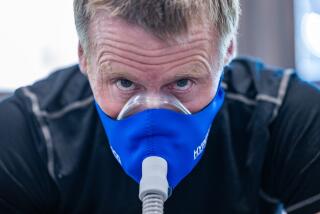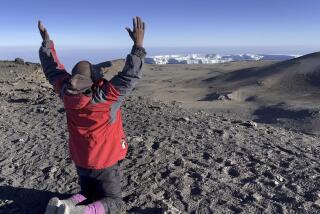Just Another Walk-Up
DOGUBEYAZIT, Turkey — Roped together, the five climbers inched slowly across Mt. Ararat’s summit snowcap.
To the east they could look across the border into the Soviet Union and Iran. To the west the 16,945-foot volcano cast a massive, dark shadow in the early morning sun.
The hikers--two Americans, a Norwegian, a German and their Kurdish guide--were breathing hard in the thin air and moving at a crawl. But when they made it to the summit, marked by a metal stake and a raggedy flag, they did what successful peak-baggers do everywhere: laughed, shook hands, slapped each other on the back and took snapshots.
Most Americans have heard of Turkey’s Mt. Ararat--Agri Dagi or Buyuk Agri in Turkish. It’s where Noah’s Ark came to rest after the Great Flood, the Bible says. Because of that, the mountain regularly draws religious pilgrims who are content with a glimpse of it from the valley below.
But it is also one of the world’s great walk-ups: what mountaineers call a peak that takes a minimum of special gear or climbing skills to get to the top.
It’s similar, say, to Japan’s Mt. Fujiyama (12,388 feet) or Tanzania’s Mt. Kilimanjaro (19,340 feet). Strong legs, strong lungs and warm clothes will help get you to their summits, too.
Ararat’s setting is dramatic. Its twin volcanic cones rise from a dry, dusty plain in a rough-and-tumble corner of the world that’s still struggling its way into the 20th Century. The mountain last erupted in 1840, devastating the villages around it.
There’s also an aura of danger and mystery surrounding the peak. Mountain guides carry shotguns to ward off vicious sheep dogs and bandits; a group of German climbers was once ambushed, robbed and suffered the indignity of returning to Dogubeyazit on foot, in their underwear.
Even for non-believers the Noah’s Ark business is a tantalizing question mark, too. The Bible says the ark came to rest “upon the mountains of Ar’arat,” so some scholars say that if it happened, it could be anywhere in the region, not just on the mountain itself.
A British writer, C. P. Lister, says searching for the ark on Ararat is “a misreading of the situation.
“The name of Ararat is preserved in the isolated peak which rises to 16,945 feet south of the Araxes; the mountains of Urartu that Noah knew were much more extensive, a great deal lower and probably some distance away, in another part of the kingdom,” Lister concludes.
Despite, or perhaps because of the mountain’s notoriety, some U.S. adventure travel companies have added Ararat climbs to their catalogues and that’s one option: Pay $100 or so a day and let someone else sweat the details.
But when a friend and I decided to go to Ararat, we wanted to make all the arrangements on our own, from getting permission from the Turkish Embassy in Washington, D.C., to hiring a guide in Dogubeyazit, the busy trading town that serves as the jumping-off point for summit climbs.
Turkish authorities require climbers, whatever their skills or experiences, to go with a guide because the mountain is so close to the Soviet Union and Iran borders.
Can you do it on your own, without paying a middleman to take care of the details? The best answer is yes, but be prepared for delays and frustrations. You’ll spend less, though it may take you longer to run the bureaucratic gantlet. But it is possible.
The problem is that the region is home to the Kurds, a seminomadic people who have a long history of sometimes-violent resistance to the Turkish government. Some of them would like to see an independent nation, Kurdistan, and government efforts to hunt down the rebels take precedence over climbers’ interest in Ararat.
The local French-speaking security chief explained the situation and then, in case of any misunderstanding, smiled and put his hands together as if they were handcuffed to demonstrate what would happen to people who ventured into the closed area.
Finally, 25 days after arriving at the mountain and after leaving and returning three times, Ararat’s weather reopened and we started for the top, a three-day walk.
The climb began with a truck ride on a dirt road, past rough villages to the 7,200-foot level, where we put most of the gear on horses. Ahmet, a friendly, quiet man who speaks some English, has been to Ararat’s summit more than 50 times. In one hand he carried an ice ax, in the other a shotgun.
A seven-hour walk took us to 11,200 feet, where we pitched tents and cooked some pasta. The second day was shorter, a four-hour scramble over loose rock to 13,900 feet. The camp was a tiny outcrop, with just enough room for the tents and horses. It was as far as the animals would go.
That night we watched the sky for signs of bad weather and went to bed early. The wind was cold, but the sky remained clear and the stars brilliant. About 3 a.m. we got up, brewed a quick cup of coffee on a backpack stove and headed for the top, using flashlights until the glow in the east was bright enough to see by.
At the snow line we strapped crampons--metal spikes--onto our boots and roped up. For all the jumbled glaciers on Ararat’s northern and western flanks, the standard route from the south--the only one permitted by Turkish authorities--involves only 20 to 30 minutes of walking on hard snow and ice.
In five hours we made the summit and were on our way down. At the high camp one of the horsemen had slices of watermelon waiting for us--in celebration.
Afterward, the question we heard most from people was, “Did you find the ark?”
No, but then again, we weren’t looking for it; we were just a couple of hikers on another walk-up.
Before you leave the United States, write a request to the Turkish Embassy, 1606 23rd St. N.W., Washington, D.C. 20008, to tell them you want to climb Ararat. They’ll send you an application, which is extremely simple. All that is required is your name and a photocopy of your driver’s license. It takes about a month to get a reply. August and September are the best climbing months because the weather is settled.
Ararat is almost as far from Istanbul as you can get and still be in Turkey, about 750 miles east of the capital. There are flights to Erzurum, but most budget travelers rely on the buses, which are modern, fast and cheap. From Ankara to Dogubeyazit, a 16-hour overnight ride, the fare is about 7,000 Turkish lira, or about $9 U.S.
In Dogubeyazit there are modest hotels for $2 to $3 per person a night. The Isfahan Hotel, the city’s one Western-style establishment, is reasonable, too, at $10 to $15, but often fully booked by overland tours heading to Iran and beyond. Its bar is the closest thing to a climber’s hangout in town.
Mountain guides will most likely find you once you arrive. Be sure to bargain hard and nail down all the details such as food, number of pack animals and any equipment you need. The price should be $90 to $120 (U.S.) per person for the three-day hike, including pack animals, food and guide fee.
The best restaurant in Dogubeyazit is Dumlupinar, featuring the same fare you’ll get all over Turkey but done very well: the cold, garlicky yogurt soup called cacik (pronounced jajik), shish kebab, rice pilaf and eggplant salad with hot chiles. For the climb you’ll have no trouble finding supplies in town: canned fish, pasta, nuts and fruit.
Don’t expect to buy climbing equipment here, except maybe a warm jacket. Take your own boots and ice ax or ski poles. Some guides have spare crampons, but there’s no guarantee.
If you get stuck waiting for local permission, there are some interesting side trips. Isak Pasha, a ruined, 17th-Century palace above town, is a quick ride by minivan. You can also take a shared taxi the 25 or so miles to Gurbulak on the Iranian border and, if you’re interested, stop at a bizarre meteor crater guarded by a soldier.
Other destinations include Hakkari to the southeast, still a stronghold of Kurdish resistance, and to the north, Kars. Nearby, there’s a ruined Armenian settlement that Marco Polo supposedly passed through.
Some women travel alone in eastern Turkey, but many say it’s not worth the trouble. Even couples should expect to have to fend off occasional aggressive men. Dressing modestly--no shorts or sleeveless blouses--seems to help. At the minimum, expect to be stared at constantly. My girlfriend said if she ever returns to eastern Turkey she’ll take along a pair of bug-eyed glasses from a joke store and stare back.
“Let’s Go: Europe” has a short but accurate chapter that covers Turkey’s major sights. Lonely Planet’s “Turkey--a Travel Survival Kit” is more detailed.
The $100-a-day trips are arranged by Mountain Travel, 1398 Solano Ave., Albany, Calif. 94706, phone (415) 527-8100. Plans are for three departures in mid-1988; the 13-day trip costs $1,395 plus air fare.
More to Read
Sign up for The Wild
We’ll help you find the best places to hike, bike and run, as well as the perfect silent spots for meditation and yoga.
You may occasionally receive promotional content from the Los Angeles Times.






